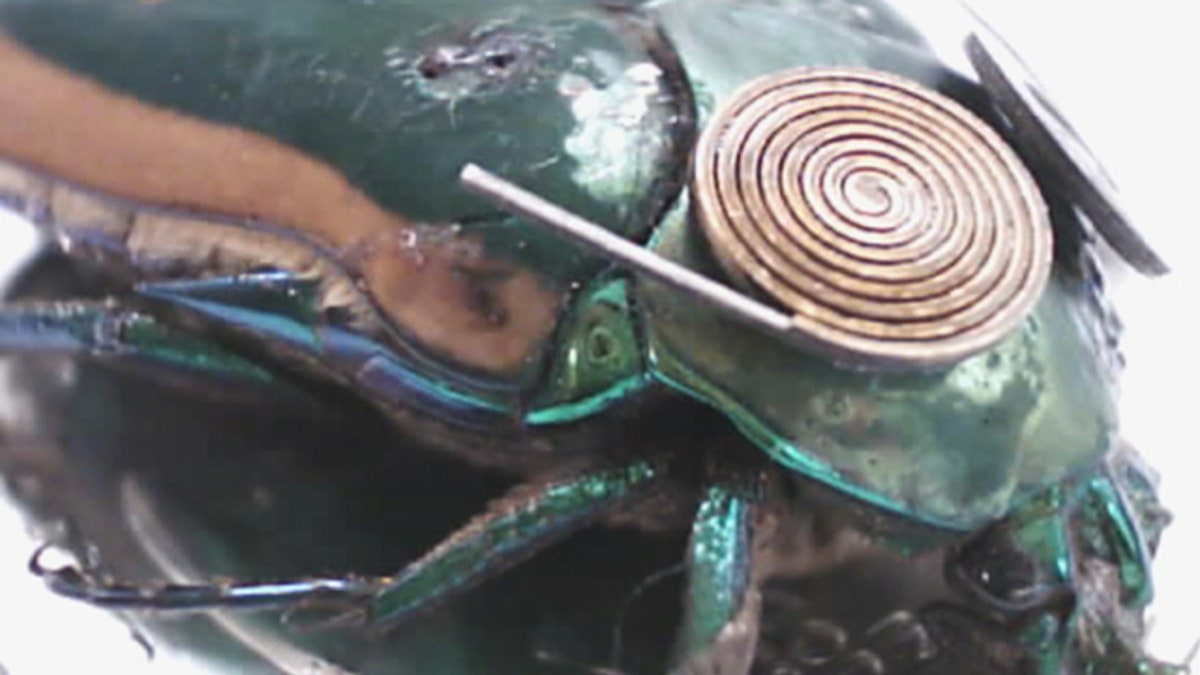
Several defense tech suppliers are busy turning bees and bugs into cyborgs, or micro UAVs -- tiny, living version of unmanned drones. (Erkan Aktakka)
Green June beetles beware: The draft never ended. You may be called upon to serve your country.
Military, commercial and academic defense research teams have been busy turning beetles and bees into cybugs, eeny-weeny cyborgs that will serve as unmanned aerial vehicles (UAVs) -- tiny, living versions of drone aircraft.
From surveillance and explosives detection to search and rescue missions, micro UAVs could be useful for a range of defense and security applications. They would have proved handy last year for monitoring the flooding in Pakistan and Thailand, or for inspecting the ravaged Fukushima Daiichi nuclear plant after Japan’s earthquake -- disaster areas where a micro UAV could be deployed rather than risk human life.
Some scientists have created UAVs smaller than 6 inches -- but 6 inches is mini, not micro. Insects are micro.
Cybugs can leverage insects’ highly evolved natural capabilities -- their natural sensors and power generation skills -- to provide cheap robot-like capabilities.
Take the honey bee. The Los Alamos National Laboratory has already demonstrated that olfactory training can exploit the bees’ fantastic sense of smell to turn them into effective explosives detectors.
The Defense Advanced Research Projects Agency (DARPA) is the single joint research and design organization for the Department of Defense. And one objective of its cyborg shop -- an initiative officially known as the Hybrid Insect Micro Electromechanical Systems (HI-MEMS) -- is to create a “reliable and stable tissue-machine interface,” fancy talk for what the public knows as cyborgs.
DARPA recently sponsored two University of Michigan researchers, Prof. Khalil Najafi and doctoral student Erkan Aktakka, to work on this sort of hybridization.
The team’s insect platform of choice is the humble green June beetle, Cotinis texana. At approximately three-quarters of an inch long and one to two grams in weight, it's clearly a huge improvement on the fully robotic 6-inch models on the market.
Moths, dragonflies, beetles and flies are often cybug candidates, but the green June beetle was a smart choice: It’s not just fast and small, it’s a robust, hard-shelled insect with solid flight performance that could be deployed during the day.
They won't go out empty-handed, of course. Researchers envision tiny backpacks for these cybugs filled with miniaturized pressure, temperature and chemical detection sensors as well as communications, microphones and cameras, according to Professor Khalil Najafi -- a goal impossible today without extra energy.
To that end, he and his colleagues have been investigating a variety of esoteric energy sources with bizarre names: magnetic generators, thermo-electric converters, resonant piezoelectric and broadband energy scavengers.
The power conundrum is where the University of Michigan team has pushed the ball forward. In the last quarter of 2011, they published their findings in the Journal of Micromechanics and Microengineering and set out a number of methods to exploit a bug's wing motion to power its payload.
According to their research, the University of Michigan’s cybug doesn't require an external energy source and can harvest enough energy from the beetle itself to charge or recharge a small battery that could operate the sensor suite.
The energy could be scavenged from either the flight muscles using a piezoelectric generator -- it would take kinetic energy from the wing movement and convert it to electricity -- or from the beetle's body heat. When flying, a beetle warms as much as 50 degrees Fahrenheit, and a thermoelectric generator could convert it to power.
Their design could also scavenge energy from tiny solar panels placed on the wings.
Another biggie for “micro hybrid insects” is controlling their movement -- basically steering the critters.
Some of the options are electromechanical and neural stimulation; optical cues with micro-optical visual presentation; and direct electrical muscle stimulation.
One of Najafi's colleagues recently developed a system similar to that of a toy plane, where a joystick can control the beetle's flight path. This team seems to have cracked the power and steering challenge, but a method is still needed to monitor and locate the cybug. Acceleration sensors may be an alternative to GPS, for example.
The university is filing for IP patents and is seeking investors to bring the cybug to market.
Just how it will be put to work remains to be seen.
Ballet dancer turned defense specialist Allison Barrie has traveled around the world covering the military, terrorism, weapons advancements and life on the front line. You can reach her at wargames@foxnews.com or follow her on Twitter @Allison_Barrie.
